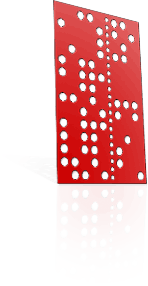Rotary 4th/Fourth Axis®20 for Roland MDX-20

The Fourth Axis®20 allows you to capture and machine the surfaces of existing objects for inclusion in jewellery, artwork, or industrial prototypes. This unique addition to your Roland MDX20 will allows you to scan objects with undercuts, hidden areas, through-holes and shadows.
Scaling, editing and combining the results with standard software, inexpensive benchtop machinery can now be used to produce rings, animals, sculptures, moulds or prototypes.
This rotary capability allows the MDX20 to spin objects of up to 70mm diameter, at the full resolution of 3070 steps per revolution.
The Fourth Axis® Interface Box:

and XYZ/Rotary changeover switch.
Elegantly designed, our interface allows you to choose regular XYZ operation or X-Rotary-Z operation, so you never need to remove the interface once it's installed. You never need to touch any Roland connectors again. Just push the black button to choose.
Hardware Mirror™ can halve the size of your parts program library. The button reverses the normal motions of the rotary, so you mill the opposite-hand version of a product you have designed. Push the silver button to select Mirror or Normal.
All our rotary axes boast these standard features:

reduction - the primary 95:18 reduction is enhanced by the
secondary 309:51 reduction
Highest resolution ever
At 3070 steps per revolution, you can show 3 times the detail and use 3 times the rotation torque, over first generation rotaries. With this level of detail, rotary scanning with PIX-30 up to 120mm diameter is now possible.
Zero backlash
Older, first generation rotaries used molded plastic gears with noticeable backlash (looseness between teeth) every time the direction of rotation reverses. This cannot be compensated by the Roland DG controller. Fourth Axis® builds double-reduction zero-backlash mechanisms into the Models 15, 20 and 30. This rotary performance can be maintained for the life of the micromachine.
48 ball bearing spindle construction
Mount your heaviest targets with confidence. Forty-eight ball bearings around a 50mm diameter main spindle can handle them. We don't charge extra for a matching 50mm chuck. It's included, with 4 independent jaws and hex adjustment key. So is our unique, detachable magnetic faceplate. So are the threaded centre-shaft, rubber cone-jaws and nuts, and a spherical tailstock.
Hardware Mirror™
When you need a left and a right handed version, you can just scan ONCE or draft ONCE in your CAD software, create ONE toolpath, then mill TWO versions. Your Fourth Axis® rotary interface includes the exclusive Hardware Mirror™ feature, selecting regular or mirror versions at the push of a button. This is not just like a mirror CAD feature. It also saves you from running your CAM program twice, can halve the size of your parts program library and ensures perfectly symmetrical chiral1 parts.
Rotary Command™ angular readout
Each Fourth Axis® rotary micromachine shows you the current rotation in degrees using laser-calibration and full time high brightness LED illumination. We used first surface mirrors (like the Hubble Space Telescope) for a perfect image through optical acrylic lenses. There's even a rotation vernier "clock" with manually adjustable zero.
Second generation micromachines
You invest in a rotary fourth axis for RESULTS. Your fine jewelry, souvenir, art of prototyping productivity all depend on fine engineering and superior performance. Our new Fourth Axis® rotaries are second-generation micromachines which break the 3000-step barrier. Using Kevlar™, Teflon™, 304 stainless steel, 6061 aluminum and anisotropic magnets, they deliver backlash-free, high resolution output and torque that competing rotaries just can't match!
Enhance your modeling machine
Our Fourth Axis®20 opens up the void under your Roland DG MDX-20 worktable, to allow nearly 70mm diameter targets to be scanned and milled. Even on the little MDX-15 the full 60.5mm diameter capacity is preserved. Our models 15, 20 and 30 let you work above and below the central axis of your target. Often, you can use a smaller machine to do larger work, when you equip it with a Fourth Axis® micromachine.
1 · chiral; handed, existing in left-hand and right-hand variants.
Specifications:
| Rotary Specifications for Fourth Axis®20 | |||
| Model name | Fourth Axis® 20 | ||
| Suitable platform | Roland MDX-20 | ||
| Gross weight | |||
| Package dimensions | |||
| Net weight (bare device) | |||
| Net weight (accessories) | |||
| X | Y | Z | |
| Working space (mm) | 203.2 | 152.4 | 60.5 |
| Max. rotational diameter | 69mm | ||
| Rotary resolution | ~3070 steps per revolution | ||
| Headstock face diameter | 43mm | ||
| Tailstock diameter | 6mm | ||
| Centre height | 39.65mm | ||
| Rotational feedrate | 0.078 - 11.72 rev/min | ||
| Max driven revolutions | 1.98 rev | ||
| Illuminated calibration | 0-360° plus vernier | ||
|
|||
| Manual | Illustrated User Manual | ||
| Available options |
|
||
|
These entries represent typical values, not specification maxima nor minima.
The specifications are subject to change without notice. Fourth Axis®, Fourth Axis 15®, Fourth Axis 20®, Fourth Axis 30®, Fourth Axis®IREO, include registered business names of Relativity PL. Roland and Roland DG are trademarks of Roland DG Corporation. Products manufactured in Australia. Copyright © Relativity Pty Ltd. |
|||
